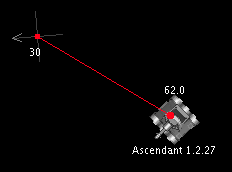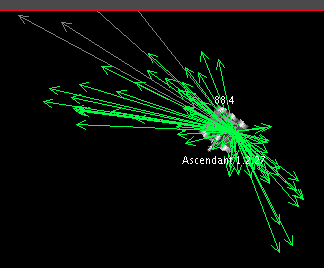Difference between revisions of "Displacement Vector"
Jump to navigation
Jump to search
(creating a page for this term; picture(s) later) |
(adding pictures) |
||
| Line 1: | Line 1: | ||
| − | + | [[Image:Displacement_vector1.png|frame|A displacement vector being collected.]] | |
| + | [[Image:Displacement_vector2.png|frame|Displacement vectors predicting potential movements.]] | ||
{{Wikipedia|Displacement (vector)}} | {{Wikipedia|Displacement (vector)}} | ||
| − | |||
A representation of a bot's relative movement that can be used in recording and reconstructing firing angles. The bot's positions at the beginning and end of a period of time (e.g., as produced by a [[waves|wave]]) form a vector relative to the bot's initial heading. The resulting vector can be applied to future situations to project the enemy's movement and deduce a firing angle. The vector may be scaled by [[Bullet Travel Time]] to adapt it to different distances and bullet powers, similar to how [[GuessFactor|GuessFactors]] are scaled by [[Maximum Escape Angle]]. | A representation of a bot's relative movement that can be used in recording and reconstructing firing angles. The bot's positions at the beginning and end of a period of time (e.g., as produced by a [[waves|wave]]) form a vector relative to the bot's initial heading. The resulting vector can be applied to future situations to project the enemy's movement and deduce a firing angle. The vector may be scaled by [[Bullet Travel Time]] to adapt it to different distances and bullet powers, similar to how [[GuessFactor|GuessFactors]] are scaled by [[Maximum Escape Angle]]. | ||
Revision as of 00:56, 24 September 2009
A representation of a bot's relative movement that can be used in recording and reconstructing firing angles. The bot's positions at the beginning and end of a period of time (e.g., as produced by a wave) form a vector relative to the bot's initial heading. The resulting vector can be applied to future situations to project the enemy's movement and deduce a firing angle. The vector may be scaled by Bullet Travel Time to adapt it to different distances and bullet powers, similar to how GuessFactors are scaled by Maximum Escape Angle.
Advantages
- The data recorded is not relative to the location of the firing bot, as a GuessFactor would be. This is important in melee, where most enemy movements are not relative to a specific opponent.
- When predicting enemy movement, projections that lead out of bounds can be ignored or adjusted.
- Reconstructing firing angles is much faster than Play-It-Forward simulation, while offering similar advantages.
See also
- Diamond uses displacement vectors in its gun.

